UNIVERSITY OF THE WEST INDIES
DEPARTMENT OF BIOLOGICAL & CHEMICAL SCIENCES
BL14A - BIODIVERSITY I : THE PLANT KINGDOM
PRACTICAL 5 : FLORAL EVOLUTION
Flowering plants dominate the earth today. There are some half a million flowering
plant species grouped into
over 300 families, based largely on flower structure. The purpose of this lab is to
introduce you to this diversity
of floral form. A range of flowering plants will be provided for you. Look upon this as a
guided tour of how the
flower has evolved! Make notes as you go along.
Flowers are collections of modified leaves - spore-bearing leaves, leaves for
protection, leaves for attraction.
The first flowers were really little different than a cone with stamens and carpels
spirally arranged
and enclosed by the perianth parts.
| Soursop, Annona muricata, has a simple flower like this. Note the fleshy
perianth parts and within - the dome-shaped mass of carpels and stamens. · At right is a photograph of a freshly opened flower (left), the same with the perianth removed (centre) and a later stage (right). By comparing the fresh flower (centre) and later stage (right) work out whether the stamens are above or below the carpels. · Relate this flower to the form of the soursop fruit |
| The flowers of water lily, Nymphaea sp., also have many features of
"primitive" flowers. Examine the flower and be sure you can recognise these:- |
 |
· large, indefinite number of flower parts · free parts (not fused) · regular symmetry · floral parts intergrade |
2. The Monocot-Dicot Divide
All (well, the vast majority of!) flowering plants fall neatly into two categories -
the Monocotyledons and the Dicotyledons.
These names comes from the number of seed leaves or cotyledons (1 or 2) on the embryo
in the seed but there are other major differences;-
| Monocotyledons | Dicotyledons | |
| 1 | Flower parts in 3's or multuples of 3 | Flower parts not ususally in 3's or multiples of 3 |
| 2 | Leaves parallel-veined | Leaves net-veined |
| 3 | Stem vascular bundles scattered | Stem vascular bundles in a ring |
| 4 | No secondary growth - no true trees! | Secondary growth - many woody plants |
| 5 | Fibrous rooted | Tap-rooted |
· Spider lily, Hymenocallis
caribaea, and Shak-shak, Crotalaria retusa, are your
"typical" monocot and dicot flowers respectively.
 |
 |
· Examine the transverse section
of a monocot stem (corn) and of a dicot stem (Sunflower).
You should already be familiar with this basic difference.
3. Flower symmetry
The simplest flowers show regular symmetry (they have several planes of
symmetry)
while more complex flowers are irregular (bilaterally symmetrical, i.e. only one
plane of symmetry).
· Is the Spider lily flower regular or irregular? What
about the shak shak?
4. Unisexual flowers
Flowers are there for sexual reproduction and most flowers are bisexual (meaning
having both male and female sex organs). In some plants flowers have only male or female
sex organs but not both. These are unisexual flowers. Some plants carry this one
step further with individual plants being male or female
| . At left are male and female flowers of the Castor Oil plant. You are supplied with male and female flowers of Jatropha integerrima (see below), a cultivated plant from Cuba, in the same family as Castor Oil.
|
· Identify which sex is which
What is the advantage and disadvantage of separating the sex organs?
Can you think of other plants with unisexual flowers?
How about the Pawpaw, Carica papaya? This is complicated, however, by the fact that individuals may be male, female or hermaphrodite (bisexual), as shown below;-.
5. Fusion of floral parts
While free (unfused) floral parts are considered the simple condition, fused flower
parts are considered advanced.
| In the Hibiscus family, Malvaceae, the carpels are fused but more conspicuously the
stamens are fused. The stamens fuse to form a special staminal tube with the anthers
congregated at the top. (To complicate things the style protrudes through this.) This is obvious in the cultivated Hibiscus but even in wild relatives, such as the one at right and the Seaside Mahoe (Thespesia populnea) flower below:-
|
| Pick apart one of the Crotalaria (shak shak) flowers. Note that the stamens are also united at their bases in a tube but not like the Hibiscus family. |
 |
Examine a flower of the Morning Glory family, Convolvulaceae. One member of this family is shown at left, Seaside Yam (Ipomoea pes-capre ssp. brasiliensis). · Note the fused petals. How many petals make up the tube? · What floral parts are the stamens fused to? |
6. Small, inconspicuous flowers but conspicuous inflorescences
Another trend in floral evolution is away from conspicuous individual flowers to
conspicuous inflorescences
(collections of flowers).
| The Daisy family, Compositae (also called Asteraceae), is an extreme
example of this. The daisy is not a flower but an inflorescence. Tiny flowers (florets) at the centre (see D at left) have the sex organs while the florets at the periphery (C, left) are sterile. · Look at the examples of this family The plant at left and below is Wedelia trilobata, Carpet Daisy. It is common throughout the Caribbean and is now used as a ground cover, especially in Florida.
|
| The flowers of the Peperomia plant before you and
shown at right are microscopic. The inflorescences have been likened to rat's tails
and metal files. The flowers can be seen in Fig. B at right. They have no
perianth parts. Peperomias are popular houseplants, many of which are native to the Caribbean and South America. · See if you can see the flowers on the
spike, |
Similar in many ways to Peperomia, but quite unrelated is Anthurium.
Peperomia is a dicot in the family Piperaceae. Anthurium is a monocot
in the family Araceae.
· Note the leaves of Anthurium, are not parallel
veined. This is one of those families that is
an exception to the general rule for monocots re: venation.
· Like Peperomia, the flowers of Anthurium are
microscopic and grouped on a fleshy spike (called a spadix).
Look at the slide showing a section through this. Observe the minute flowers.
· Run your finger along the spadix of several of the
Anthurium blooms in the lab. Hopefully some will feel
moist, others will be dry and powdery. This is a way for the plant to prevent
self-pollination.
When the spadix is moist the stigmatic surfaces are receptive. When it feels
dry and powdery,
the pollen is being shed!
· Lastly, look at that bright coloured flap attached to the
base of the spadix. This is the spathe
and is really a highly modified leaf. This brings us to the last type of
modification we will discuss.
| Blooms of the cultivated Anthurium with brightly coloured spathes. photo picture-gallery.com |
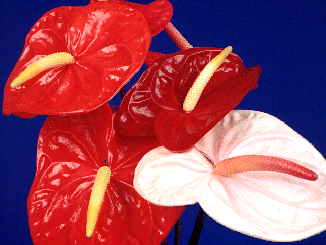 |
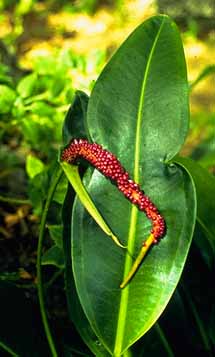 |
The plant at left is Anthurium willdenowii. It is a wild anthurium, endemic
(unique) to the Lesser Antilles. Note its spathe is green and leaf-like, not showy like cultivated anthuriums. The spadix is fleshy and covered in small, purple fruit which have developed from the minute flowers of the spadix. |
7. Bracts
Sometimes the flower itself is not so conspicuous but instead it is a modified leaf
attached
to a flower stalk that is showy. Such leaves are called bracts. Not surprisingly,
because of
their attractiveness many of these plants are cultivated as ornamentals. Poinsettia,
Euphorbia pulcherrima, is a good example. The bright red bits are bracts with some
very
inconspicuous flowers at the centre of the grouping.
Let's look at a few other examples
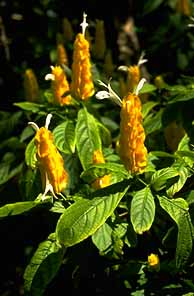 |
This is a garden plant, the lollipop plant, Pachystachys
lutea, a member of the Acanthaceae, a family known for its colourful
bracts? What colour are the petals? |
| What colour are the flowers in this Red Ginger, Alpinia purpurata? |  |
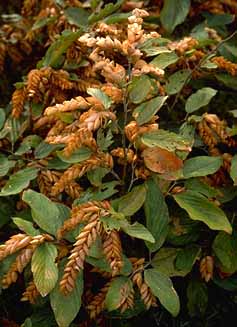 |
You can't actually see the flowers in this photo of the Wild Hops plant, Flemingia
strobilifera? Find the plant and look at an inflorescence with greener, less dry bracts. You
should be able to find the flowers hidden within. Which of the plants that you have
looked at so far does its flower bring to mind? |
| Look at the bougainvillea inflorescence. What colour is the bract compared to the
flower? |
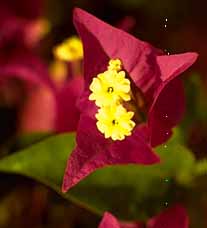 |
| I hope you enjoyed this brief look at a few aspects
of floral structure. There are some quarter million species of flowering plants in the world. In this brief excercise we have only scratched the surface of this diversity! |
![]()